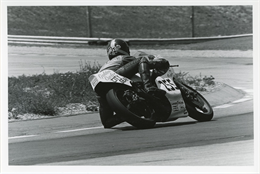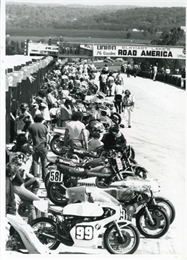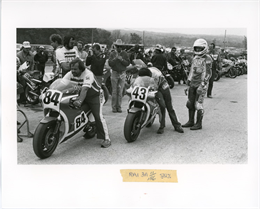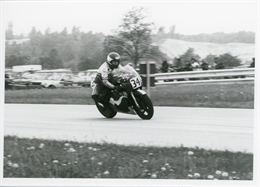Superbikes

Start of the 1983 Superbike race at Road America. Photo by Dan Schlosser. Courtesy of Road America Archives.
Road America’s track is not just for cars. Beginning in 1980, the American Motorcyclist Association (AMA) sanctioned motorcycle races at the track. Since then, motorcycle races have provided enthusiasts with opportunities to see awe inspiring racing, get up close to the amazing bikes, and socialize with fellow motorcycle enthusiasts.

Crouched 250 rider leans his bike, knee low, at Turn 5 during the 1980 races at Road America. Photo by Mark S. Ruther. Courtesy of Road America Archives.
The idea of motorcycle racing at Road America is older than many realize. After WWII, motorcycle popularity followed a similar trajectory to racecars. When Clif Tufte envisioned Road America in 1954, plans for expansion would have added a future 2-mile motorcycle track. Although there was some preliminary design and earthwork done, the separate course was never built. For the next 25 years, the closest motorcycle racing ever came to Road America was when motorcycle riders competed in car races. Successful riders who excelled in auto racing include 2-time AAA/USAC Stock Car champion Paul Goldsmith, and sports car and IndyCar driver Danny Ongais.

Bikes parked the in the pits prepare for the first motorcycle race at Road America, 1980. Photo courtesy of Road America Archives.
When Sportbikes became popular in the 1970s, interest expanded to road racing. The AMA started sanctioning road races in 1976, and Road America was an appealing venue. After several years of research, Road America added AMA sanctioned races to the track lineup. Since then, it has remained one of North America’s longest, most challenging motorcycle courses!

Xavi Fores, riding his Ducati Panigale V2, zooms around Turn 7 on his way to winning the 2023 SuperSport race. Photo by Tim Kemmis. Courtesy Road America.

Sidecar racing is popular with fans. Here winners Pete Essaff and Dennis Krueger round Turn 6 at Road America in 1982. The passenger, sometimes referred to as the ‘monkey,’ shifts his weight to improve the bike’s stability while cornering. Photo by James F. Quin. Courtesy of Road America.
Motorcycle racing at Road America requires awe defying skill. It is seemingly a competition for daredevils. Drivers race within inches of crashing. Speeds on straights can reach 200 mph! Racers practically touch the ground leaning into corners. They can even see pebbles on the road surface zip by centimeters from their visor. Amazing, considering all that grips the bikes to the pavement is a tire contact area about the size of two fifty-cent pieces! For safety, Road America added an extra bend for motorcycle races near The Kink that reduces speed going into the turn; otherwise, the track would be too dangerous. A competitive win at Road America is a sign of a driver's skill, professionalism, and the bike’s engineering. Even more of a feat when racing in the rain!

Eddie Lawson on his way to a cold, damp win at Turn 12, Canada Corner, in the 1982 Superbike race at Road America. Lawson was a 2-time AMA Superbike Champion and would go on to be 4-time FIM 500 cc World Champion and inducted into the MotoGP Legends Hall of Fame. Photo by Richard M. Koehler. Courtesy of Road America Archives.

Five-time AMA Formula One Champion and all-time wins leader Mike Baldwin prepares to mount his bike, #43, at start of the 1983 race. Photo by Dan Boyd. Courtesy of Road America Archives.
Racing at Road America has been a launching point for many motorcycle racers’ careers. Many legendary racers have competed at Road America, including 3-time AMA Superbike champion Doug Chandler, MotoGP World Champion Nicky Hayden, AMA Superbike champion and 3-time MotoGP 500cc class world champion Wayne Rainey, and 3-time MotoGP world champion Freddie Spencer.

Field of bikes make their way around Road America’s track, 1980. Photo by Mark S. Ruther. Courtesy of Road America Archives.
Surprisingly, anticipation of Road America’s first motorcycle race weekend brought fear and trepidation to some area residents unfamiliar with the sport. Some feared a weekend of ‘Hell’s Angels’ taking the track. According to Road America historian Tom Schultz: “The first event was greeted with near panic in the surrounding area. Apparently, a portion of the populace had seen Marlon Brando in The Wild One too many times...” Peter Egan and John Ulrich noted their article “Motorcycles at Elkhart Lake” in the October 1, 1980, issue of Cycle World that one hysterical newspaper headline read “Cycle Invasion Strikes Fear at Elkhart Lake." The article predicted business closures, heavy police presence, riot trained crowd control, and police dogs.
All the fear mongering was completely unnecessary. Area residents found out that racing motorcycles are not custom ‘hog’ bikes at all, but powerful, agile, light-weight racing motorcycles. Superbike racing is a technical, professional sport, and Elkhart Lake residents have subsequently welcomed motorcycle racing ever since.

Wes Cooley on bike 34 won the 72-mile 18 lap 1980 Road America Formula One motorcycle race with an average speed of 95.9 mph. Cooley would go on to win the 1980 AMA Winston Cup and Pro National Championship. Courtesy of Road America Archives.
Fans enthusiastically welcomed motorcycle racing to Road America right from the start. Peter Egan and John Ulrich noted that Road America opened professional motorcycle races to a Midwest audience. Fans no longer had to trek 900 to 1000 miles to just to see a race. For some lifelong fans, Road America’s 1980 motorcycle race was the first-time they ever had the opportunity to see a motorcycle road race in person.
Fans come to support their brand. The 1990s saw factory-backed teams from Yamaha, Honda, and Suzuki dominate entries. Other factory teams have joined in over the years, including Harley Davidson, Kawasaki, Ducati, and KTM. Basketball legend and bike fan Michael Jordan’s team has even raced at Road America.

Tyler O'Hara on his Indian during the 2023 King of the Baggers race. These bikes are racing versions of popular Harley Davidson and Indian street bikes. They're called 'baggers' because they have the saddle 'bags' straddling the rear wheels. Photo by Tim Kemmis. Courtesy of Road America.
Superbikes remain a long-lived fan favorite at Road America. In fact, Road America has the longest uninterrupted run of superbike championships of any circuit in North America! Several classes of motorcycle competition take place today: Medallia Superbikes, SuperSport, Stock 1000, Junior Cup, Mission King of the Baggers, and Royal Enfield Women’s Build.Train.Race.

Photo by Dan R. Boyd. Courtesy Road America Archives. Photo by Dan R. Boyd. Courtesy of Road America Archives.
MotoAmerica Superbike weekend is now paired with Vintage MotoFest, a ride-in vintage motorcycle show. Road America is popular because it provides opportunities for enthusiasts to get up close and admire the amazing bikes, meet the Superbike racers in the paddock, and socialize with fellow bike enthusiasts.

Sidecars start their race at Road America, early 1980s. Capable of going 140 mph, sidecars ran every AMA Camel Pro Series road course event. Photo by Unger Photo. Courtesy of Road America Archives.
[Sources: Interview with Road America staff Tim Kemmis, John Ewert, Spring 2023. Schultz, Tom. Road America: Five Decades of Racing at Elkhart Lake. Indianapolis, IN: Beeman Jorgensen Inc., 1999; Schultz, Tom. Celebrating 50 Years of Road Racing. Elkhart Lake, WI: Road America, 2004; Peter Egan and John Ulrich. “Motorcycles at Elkhart Lake” Cycle World, October 1, 1980.]
